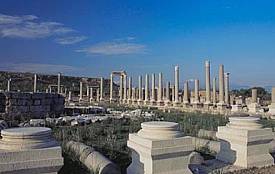| |
Guides in Turkey
Antalya Museum
Antalya Splendors of the Taurus Mountain
Antalya-Aspendos
Antalya Termessos & Duden Waterfall
Antalya Perge & Side
Olympos & Phaselis
Olympos-Chimera (Cirali)-Burning Mountain
Antalya Termessos
Antalya-Koprulu Canyon
Antalya Waterfalls (Duden, Kursunlu & Manavgat)
Antalya-Caves (Altinbesik & Karain)
Antalya Sillyon
|
 Antalya Perge & Side Antalya Perge & Side
Request this tour
Perge is 18 km. east of Antalya between the Duden and Aksu streams. This is reached along the Antalya-Alanya highway, turning north at Aksu, going 2 km. further on. As it was not located on the coast, it was not subjected to raids by pirates and therefore continued its progress without interruption. It was settled in 1200 B.C. In 223 B.C. Perge, like Side, reached an agreement with Alexander and thus did not go to war or suffer the usual ravages. It lived through the Hellenistic, the Roman and the Byzantine epochs. Its 15,000 spectator theater was built in the 2nd century A.D., and the nearby stadium could hold 12,000 people. With the exception of the Aphrodisias stadium, it is the best preserved in Anatolia. There are 30 rooms, believed to have been used as shops, underneath the stadium seats. A great many statues and other valuable items have been unearthed in recent digs, many of which are in the Antalya Museum. Some of the things worth seeing in Perge are the Hellenistic gate, the agora, the nymphaeum, the colonnaded streets, the sarcophagi, the basilica and the acropolis.
Side is reached by turning south 3 km. before Manavgat on the Antalya-Alanya highway. The exact date of its founding is not known. In the language of Anatolia, "Side" means Pomegranate. From inscriptions it appears that Side dates back to the Hittite Period. The city was constructed on a peninsula and was a Hellenistic and Roman town, protected by city and sea walls. One's attention is particularly drawn to the city gates and walls, as well as many remains of aqueducts which brought water from the foothills of the Taurus Mountains and the surrounding country. The old baths have been restored and turned into a museum, in which are exhibited some of the statues and art treasures found in Side. One of its most important buildings is its 15,000 spectator theater. The difference between this Roman theater and other antique theaters in the region is that it is not built against a hillside. The 2 storey theater, built on a series of arches, is 20 m. high. The orchestra and the stage are in a state of ruin. Rainwater canals run under the theater. Side has colonnaded streets, a triumphal arch, a harbor, baths, fountains, cisterns, aquaducts, temples and an agora.
|